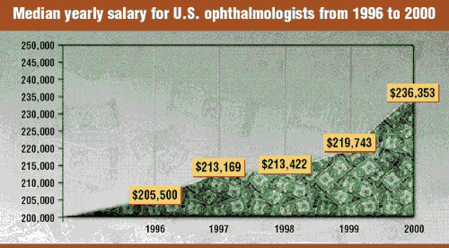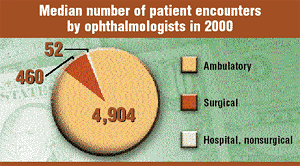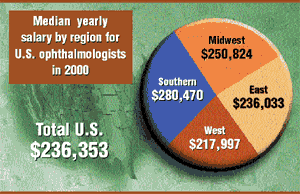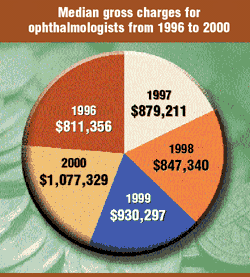National survey: compensation increases for ophthalmologists
Surgeons in the Southern United States, in single-specialty practices and those with no revenue from capitation are bringing home the biggest paychecks.
Salaries have risen for ophthalmologists in the past 4 years, according to a recent survey. The 2001 report on physician compensation and production from the Medical Group Management Association says surgeons’ yearly pay increased by 15% in 2000. However, salary increases were outpaced by increases in their gross charges.
Data for the survey were gathered from 402 ophthalmologists in 125 medical practices. Health care providers shared their rates of compensation, professional charges, their numbers of ambulatory and hospital encounters and the extent of their surgery and anesthesia services.

Compensation
From 1996 to 2000, the median salary for ophthalmologists rose 15.01%, from $205,500 to $236,353. Slightly more than half of this increase took place between 1999 and 2000.
“When comparing all major specialties, a typical ophthalmologist’s salary is pretty close to other specialties,” said Daniel P. Stech, director of survey operations at MGMA.
|
|
Geographically, providers in the Southern United States had the highest income, with a median of $280,479 in 2000. Those in the Midwest followed with $250,824, and providers in the East came in third place with a median salary of $236,033 per year. Surgeons in the West were last, with a median salary of $217, 997 per year.
Physicians who worked solely in ophthalmology single-specialty practices earned a median of $297,419 per year. In contrast, their peers working in multispecialty practices earned a median of $223,682, or $74,000 less, in 2000. According to Mr. Stech, this difference can often be attributed to revenue and expense sharing with primary care physicians in multispecialty practices.
“Specialists in a practice with family practitioners, or physicians who have a smaller income, generate more revenue than their associates. Since they make more money, they often share the expenses by subsidizing themselves and their associates,” he said.
Salary by years of service
In 2000, income measured by years of service varied by almost $100,000. Ophthalmologists just starting out in the field made a median of $155,601 in the first 1 to 2 years. Naturally, this starting salary fluctuates according to regional and subspecialty practice demands, Mr. Stech said. A surgeon just opening his or her own private practice will earn less in the early years than a surgeon beginning a career in a bustling refractive center.
U.S. ophthalmologists in practice for 3 to 7 years earned a median of $232,185. This increased by about $8,000 for surgeons in practice for 8 to 17 years. The median income for seasoned ophthalmologists with 18 or more years of experience climbed to $247,456 per year.
While compensation for ophthalmologists rose considerably, the rate of increase was not as significant as that for optometrists, whose pay went up 17.02% in the past 4 years. The median optometrist’s salary rose from $77,450 in 1996 to $90,631 in 2000.
Salaries lower under capitation
|
|
Compensation levels for specialties are affected by capitation, the monthly per-capita reimbursement allotted by health care plans. Ophthalmologists who charge per service rendered instead of working through these fixed yearly rates made a median of $288,617 in 2000. Most ophthalmologists in the survey reported no revenue from capitation.
Their peers who took in 10% or less of their revenue from capitation earned a median salary of $226,890. Surgeons who generated 11% to 50% of their revenue through capitation earned $208,600, while those whose revenue was made up of 51% or more capitation took home a median of $225,610 a year.
Mr. Stech speculated that doctors who get paid primarily through capitated programs might take home more than those with smaller bases of HMO and capitated patients, because they have “perfected” how to work within a capitated system.
“After a certain point, clinical and business management becomes re fined with more experience,” he said.
Patient encounters
|
|
The number of ambulatory encounters performed by ophthalmologists was 4,904 in 2000.
“This number dropped from 1999, when there were over 5,000 ambulatory encounters,” Mr. Stech said.
Ophthalmologists performed a median of 460 surgical cases in 2000. However, this number rose to nearly 1,000 cases for surgeons in the 75th and 90th percentiles of this survey measure.
Excluding surgical encounters, physicians had a median of 52 hospital encounters in 2000. This rose to 349 encounters for those in the 90th percentile.
Charges for services
Physicians’ gross charges for 1 year of patient care rose 32.78% from 1996, jumping from $811,356 to $1,077,329 in 2000. The largest increase took place between 1996 and 1997, when charges rose 8.36% in just 12 months.
However, this overall 4-year rate increase was not as significant as the rate increase for optometrists, whose gross charges rose 56.30%.
“Of the $1 million in gross charges generated by ophthalmologists, they collected a median of $697,532 per physician. Physicians rarely collect their entire gross charges because of the contractual discounts they must provide health plans,” Mr. Stech said.
For Your Information:
- Daniel P. Stech, director of survey operations for Medical Group Management Association, can be reached at 104 Inverness Terrace E., Englewood, CO 80112; (303) 799-1111, ext. 238; fax: (303) 643-9567.
- Data taken from: Medical Group Management Association. 2001 Physician Compensation Production Survey: 2001 Report Based on 2000 Data.



